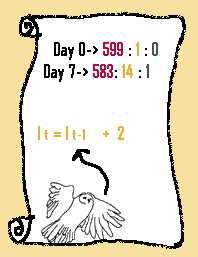A really simple model
 The first line of the scroll gives the initial conditions of the model – in other words, what the population looked like in the initial or early stages. The second line gives the current status of the population. The third line is the beginning of a very simple model (much too simple, but we’ll use it to demonstrate how to go about setting up a better model).
The first line of the scroll gives the initial conditions of the model – in other words, what the population looked like in the initial or early stages. The second line gives the current status of the population. The third line is the beginning of a very simple model (much too simple, but we’ll use it to demonstrate how to go about setting up a better model).
The model we are building uses rates of change. In other words, if I know how many people are in each compartment today, and I know how many people are moving (or changing compartments), then I know how many people will be in each compartment tomorrow. This process is called iterating the model.
So the equation
It = It-1 + 2
says that in order to find todays number of sickies, I take yesterday’s number and add two. Or in simpler language, every day 2 more people get sick. But where is the rate of change in this equation, you may ask. That is a good question. In fact you need to rearrange the equation slightly to see it as a rate of change:
It - It-1 = 2, or
Delta I = 2
Since the delta notation is more compact, we’ll use it from now on.
Copyright University of Maryland, 2007
You may link to this site for educational purposes.
Please do not copy without permission
requests/questions/feedback email: mathbench@umd.edu